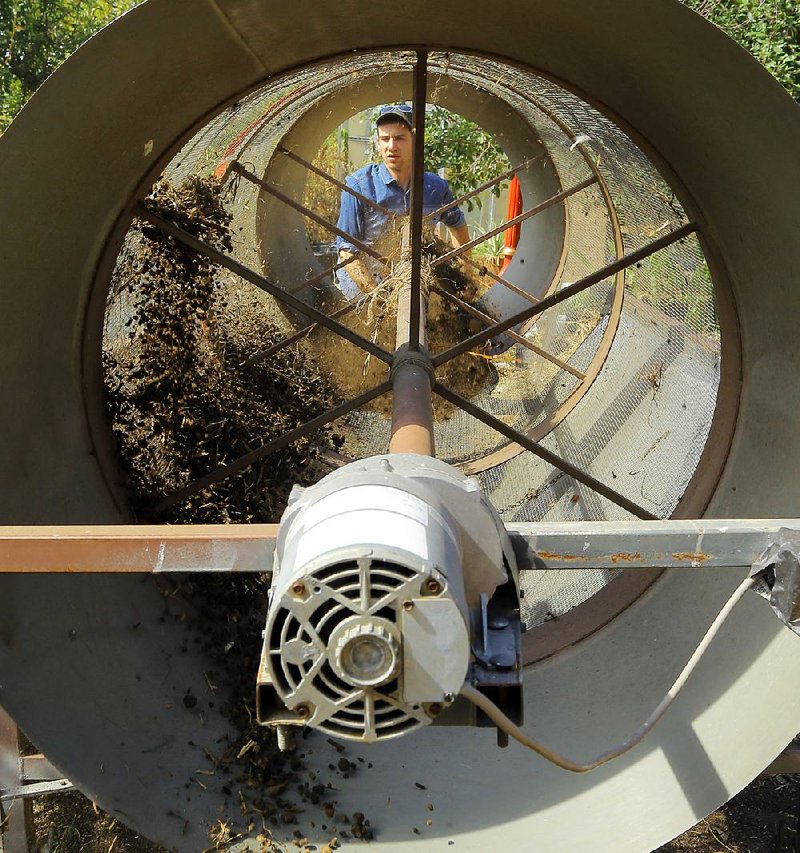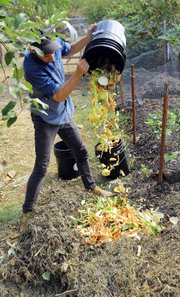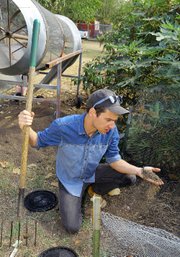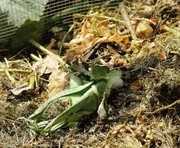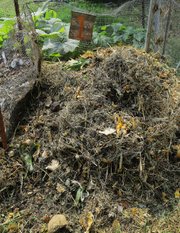When it comes to turning kitchen scraps and yard waste from eyesore into gardening gold, the process can be overwhelming.
From buying the right containers and the right ingredients to having the patience to wait for nature to do its thing, the call to compost can seem like a complicated one. But new businesses, tools and a few old-school tricks can help simplify the process. Experts say the results are worth it. There's a reason devotees call compost's crumbly, dark, textured supersoil "black gold."
"Compost improves so much of your soil," says Katie Teague, Washington County extension agent with the University of Arkansas Division of Agriculture. "It can help loosen up heavy clay soil, or for sandy soil it can help increase water-holding capacity."
And then there's the environmental boost. For Read Admire of Little Rock, composting is a way to save thousands of pounds of food waste and kitchen scraps from languishing in landfills. Admire got the idea for a business he has dubbed The Urban Food Loop while working as a cook at the now-closed Little Rock restaurant Natchez. In the kitchen, Admire was working with local, organic produce and approached owner Alexis Jones about composting the leftover peels and spare bits, rather than trashing them.
Soon, Admire had expanded to including scraps from South on Main's restaurant kitchen and pitched the idea for the Loop (a business where Admire picks up scraps from customers, composts them at a farm and brings compost back to the customers or donates it to local farms) to the Clinton Global Initiative University.
The Clinton School of Public Service graduate got a grant for the project, and now has 21 Little Rock customers. Of those, 70 percent are donating their compost to area urban farming and hunger relief projects.
While Admire now works with 300-400 pounds of compost per day, he relies more on muscle than machines to get the process going, turning the piles by hand with a pitchfork daily.
Going old school
The basics of composting are so simple there's a children's book on the subject. In Mary McKenna Siddals' Compost Stew: An A to Z Recipe for the Earth, the author looks at compost as a recipe.
"Environmental chefs, here's a recipe for you/to fix from scratch/to mix a batch/of Compost Stew."
In Siddals' recipe? "Apple core; Bananas, bruised; Coffee grounds with filters, used."
It's elementary, but Teague says the recipe is accurate. To thrive, compost needs a mix of what gardening experts call "brown material" and "green material." The brown side includes dead leaves, browned grass clippings or newspaper. On the green side: organic matter that infuses the mix with nitrogen, including fruit and vegetable scraps. Add moisture, oxygen and time, and Teague says you're on your way to a pile of black gold.
Teague says that gardeners can get started composting without any specific gear.
"Compost happens with or without human involvement," Teague says. "We just try to speed it up a little."
To get started, Teague recommends a simple compost pile of layered fall leaves, grass clippings and kitchen scraps with a ratio of two-thirds brown and one-third green material. Maybe throw in a few shovelfuls of soil for good measure.
"The smaller the chunks of vegetable scraps are, the better," she says.
Teague recommends avoiding adding any fats, oils or meats to the pile to avoid a rancid smell.
Once the pile is created, turning the pile once a week with a rake or shovel helps oxygen and moisture permeate throughout. Teague recommends keeping the pile as moist as a wrung-out sponge.
"If you leave a pile on its own without adding any moisture or turning, it can be six months to two years before you see results."
Adding air, moisture and maintaining the right balance of brown and green materials can shorten decomposition time to just a few months. But novice composters, be warned: Just because a compost pile starts big doesn't mean it will end that way.
"If you start with a pile that's a cubic yard, you might end up with a quarter or fifth of that," Teague says.
Getting in gear
Homeowners looking to get their composting off the ground -- literally -- can opt to invest in a specially made compost bin or tumbler, available at big box stores like Home Depot or Lowe's. The tumblers (which can cost as much as $200 for high-capacity versions) allow users to add their materials to a sealed trashcan-like bin that is rotated weekly.
Looking to spend less? A plastic trash can or bin with a resealable lid will work. Just poke a few holes in the sides to allow airflow and shake periodically.
Those looking to speed up their composting process can do so by adding worms to the mix in a process called vermicomposting. Companies like The Worm Factory (naturesfootprint.com/worm-factory) offer kits that include stacking trays, worm bedding and, of course, composting worms that work to break down organic material added to their bins. According to The Worm Factory, the creepy crawlies can eat up to half their weight in food each day, and it takes about three months for a 12.5-pound tray of scraps to be fully composted.
Gardeners can also buy boxes of "compost starter" at many gardening supply stores or online at sites like Amazon.com. Most starters include nitrogen-rich alfalfa, bacteria and microbes that work to break down organic matter.
A hired hand
If all the talk of turning, piling and generally maintaining a compost pile has you queasy, Admire is your man. His Urban Food Loop is composting at its most simple -- you pile up the kitchen scraps; he hauls it away and brings you the black, crumbly earth of gardening dreams in spring or fall. Amounts of compost available for delivery will increase as participation in the program grows. Membership in The Urban Food Loop is $31 per month for weekly pickup and, so far, membership is limited to those living in the downtown, Hillcrest, Stifft Station and Midtown regions of Little Rock. Admire hopes to expand his business to 50 customers by 2016 and slowly expand his territory.
Much of Admire's donated compost goes to the Arkansas Hunger Relief Alliance's Gleaning Garden, which grows produce to donate to local food banks.
"The goal is to bridge the gap and connect people to their food," Admire says. "To use local food as a way to fight food insecurity and promote social justice."
For those interested in hearing Admire's story, and gleaning some composting tips firsthand, he will host Composting 101: An Urban Composting Workshop from 6 to 8 p.m. today at Little Rock Urban Farming, 5910 G St. in Little Rock. The class is $35 and tickets can be bought at the door. The class will be co-hosted by I Love JuiceBar and will include juice samples.
For more information on the class, and Little Rock Urban Farming, go to southerncenterforagroecology.org. For more on The Urban Food Loop, visit theurbanfoodloop.com.
HomeStyle on 11/07/2015
